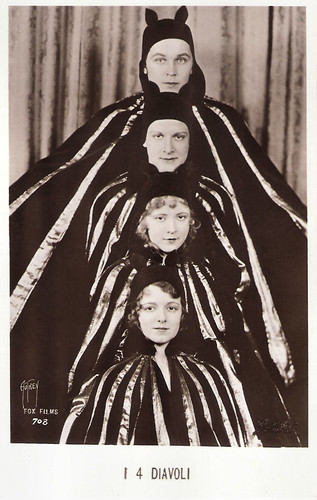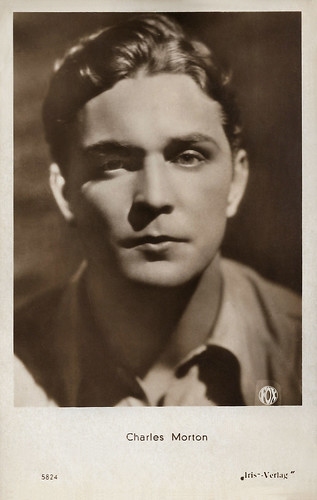
Italian postcard by G.B. Falci Editore, Milano, no. 720. Photo: Max Munn Autrey / Fox. Janet Gaynor and Charles Morton in 4 Devils (Friedrich Wilhelm Murnau, 1928).

Austrian postcard by Iris-Verlag, no. 5668. Photo: Fox-Film.

French postcard by Europe, no. 834. Photo: Fox / Astra Cinegrafica.

German postcard by Ross Verlag, no. 5466/1, 1930-1931. Photo: Fox.

British postcard in the Film Partners Series, London, no. PC 64. Photo: Metro-Goldwyn-Mayer. Charles Morton and Anita Page in Caught Short (Charles Reisner, 1930).
The most mourned of the lost films of the silent era
Charles Morton was born in 1908 in Illinois, USA. Morton spent his adolescence in Madison, Wisconsin, and received his education at Madison High School and the University of Wisconsin–Madison.
He made his first stage appearance at the age of seven and later appeared in vaudeville, stock, and the legitimate stage. At the age of 19, Charles was discovered by film director Randall Faye while starring in a stage production of 'Romeo and Juliet' in Los Angeles. Impressed by his polished physical appearance, personality, and youthful charm, he arranged for him to be a career in the film industry.
Morton signed his first contract with Fox in 1927. Under the supervision of Randall Faye, he made his film debut in Rich But Honest (1927). Audiences first discovered the handsome youth that same year as the dashing Terry O'Flynn opposite the studio's leading flapper, Madge Bellamy, in Colleen (Frank O'Connor, 1927), one of the era's many comedy-dramas.
Morton went on to star in John Ford's World War I silent film Four Sons (1928) with Margaret Mann and James Hall. It is one of only a handful of survivors out of the more than 50 silent films Ford directed between 1917 and 1928. He also starred in Fox's None but the Brave (Albert Ray, 1928) with Sally Phipps as Mary.
Charles Morton was also a member of the ultimately tragic circus troupe in F. W. Murnau's near-classic 4 Devils, among the most mourned of the lost films of the silent era. The plot concerns four orphans (Janet Gaynor, Nancy Drexel, Barry Norton, and Charles Morton) who are raised by an old clown and become a high wire act. But there are sinister goings-on at a circus. 4 Devils was released by Fox Film Corporation and was produced by William Fox, who had hired Murnau to come to the United States. It was initially released as a silent with a synchronised music score and sound effects in October 1928 and grossed $100,000 in New York City, but because of the talkie picture craze, Fox pulled it from distribution and ordered sound to be added. No copies of either version of the film are known to exist.

Spanish postcard by “MC Barcelona”, no. 58. Collection: Marlene Pilaete.

French postcard by A.N., Paris, no. 279. Photo: Fox Film.

Italian postcard by G.B. Falci Editore, Milano, no. 708. Photo: Max Munn Autrey / Fox. Janet Gaynor, Nancy Drexel, Barry Norton, and Charles Morton in 4 Devils (Friedrich Wilhelm Murnau, 1928).

Italian postcard by G.B. Falci Editore, Milano, no. 711 Photo: Charles Munn Autrey / Fox. Charles Morton, Janet Gaynor, Nancy Drexel, and Barry Norton in 4 Devils (Friedrich Wilhelm Murnau, 1928).

Austrian postcard by Iris-Verlag, no. 5824. Photo: Fox.
A few days behind bars
Charles Morton had a supporting part in the sound comedy Check and Double Check (Melville W. Brown, 1930) based on the Amos 'n' Andy radio show. The title was derived from a catchphrase associated with the show. It starred Charles Correll and Freeman Gosden, in blackface, in the roles of Andy and Amos, respectively, which they had created for the radio show. The film also featured Duke Ellington and his Cotton Club Orchestra.
In 1931, Charles Morton married Lya Lys, but the marriage ended in divorce some months later, not long after the birth of their daughter. Later a dispute over alimony payments would see Morton spending a few days behind bars.
After 1933 with the widespread use of sound film, Morton's career began to lose momentum; and by 1936 his roles were significantly reduced, playing minor roles on television until his death from heart disease in 1966, at the age of 58.
Even though Charles Morton's career continued into the mid-1960s, almost all of his roles after 1933 were so minor he was left uncredited for the majority of his performances.
Charles Morton was cremated and his ashes interred in an unmarked grave in Valhalla Memorial Park, North Hollywood, Los Angeles County, California. According to IMDb, he was married three times. His wives were Lya Lys, Frances Lane, and Lola Resk.

German postcard by Ross Verlag, no. 4392/1, 1929-1930. Photo: Fox.

German postcard by Ross Verlag, no. 4858/1, 1929-1930. Photo: Fox.

German postcard by Ross Verlag, no. 5002/1, 1930-1931. Photo: Fox.

German postcard by Ross Verlag, no. 5411/1, 1930-1931. Photo: RKO Radio Pictures. Charles Morton and Sue Carol in Check and Double Check (Melville W. Brown, 1930).

German postcard by Ross Verlag, no. 5820/1, 1930-1931. Photo: Fox.
Source: Lowell Thurgood (Find A Grave), Wikipedia, and IMDb.
No comments:
Post a Comment